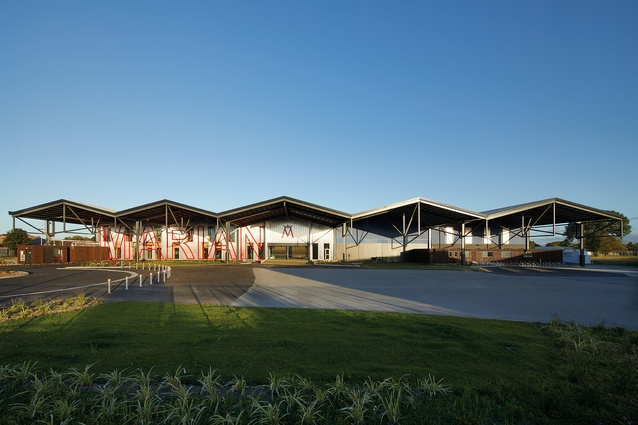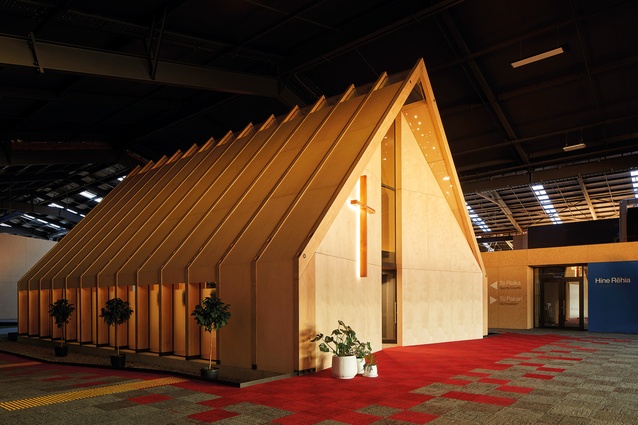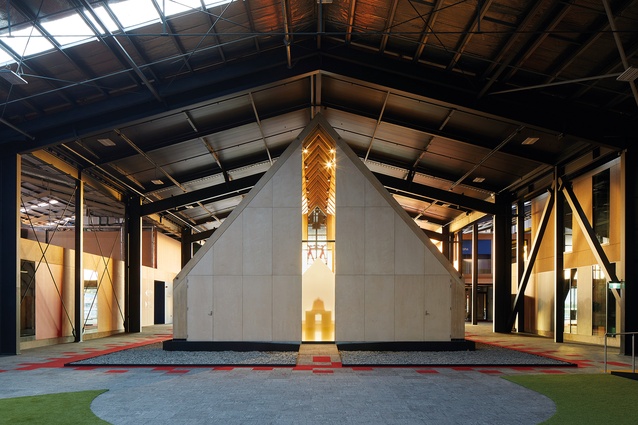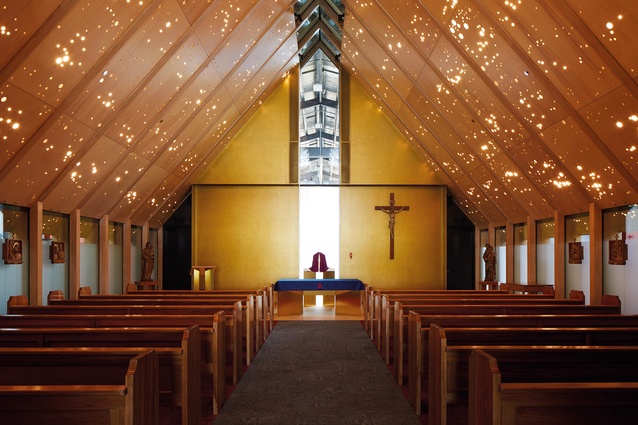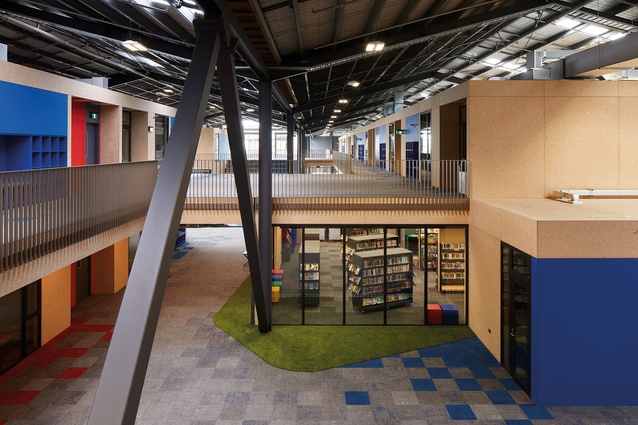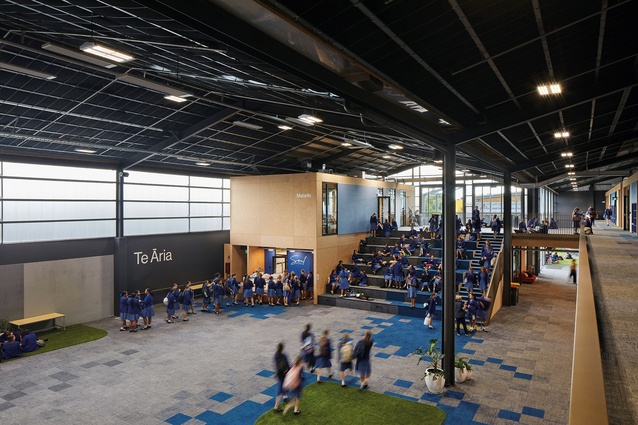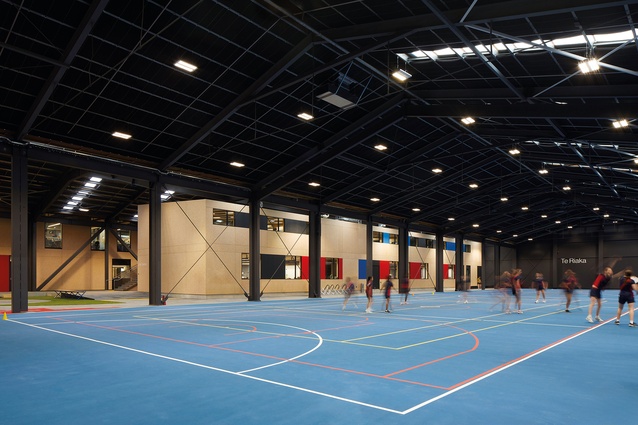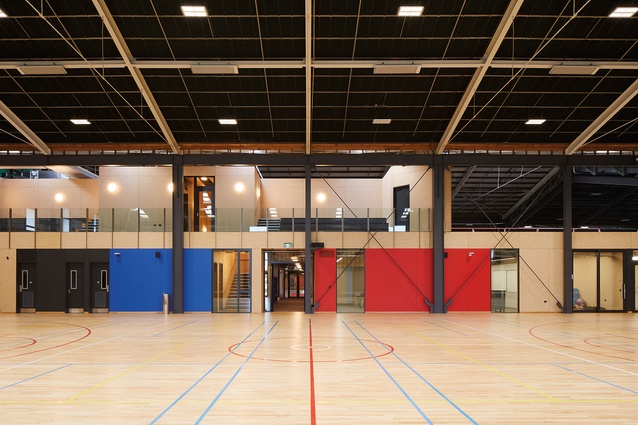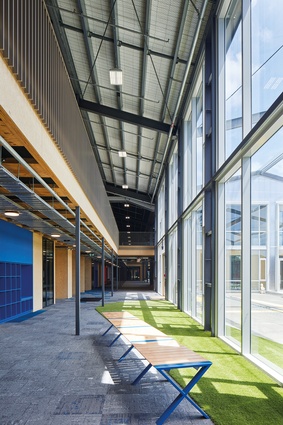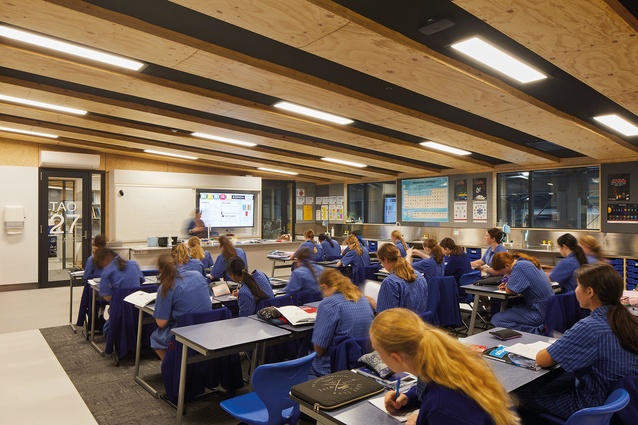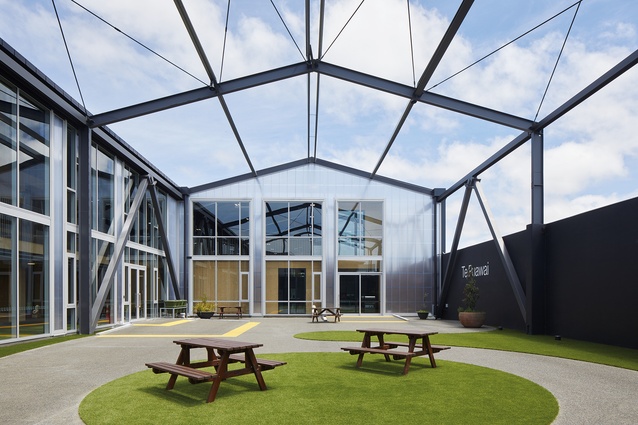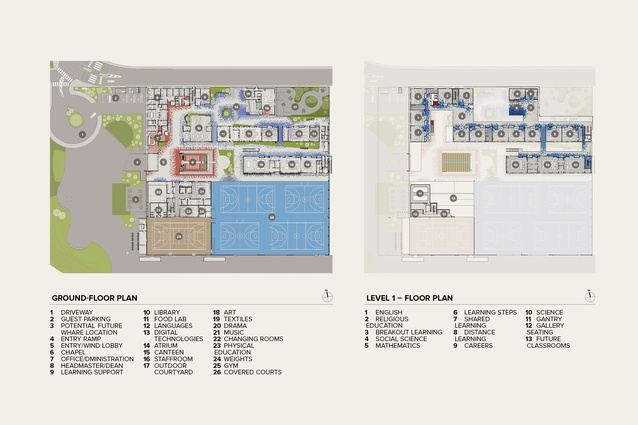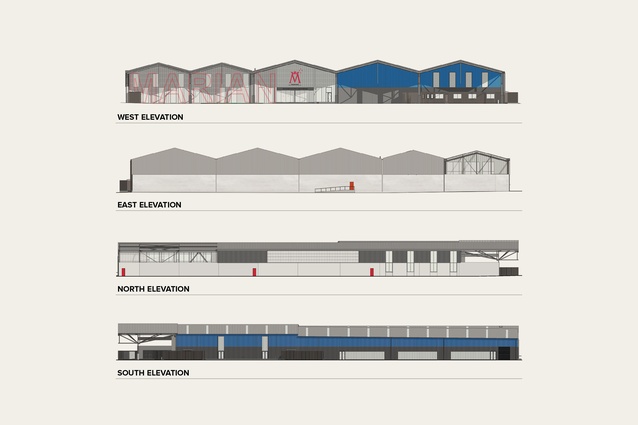Under the roof
Abigail Hurst looks at Marian College, the bold transformation of a former Foodstuffs distribution centre by Sheppard & Rout Architects, and what it says about sustainability and schools of the future.
Giant, bold, red lettering enlivens the steel, glass and polycarbonate façade under the roof of Marian College, an all-girls Catholic high school in Christchurch that has made itself a home in an unlikely place – a 17,000m2 former Foodstuffs warehouse. Inside, the school chapel takes centre stage, like a honed timber jewel against its industrial background and signifying the importance of faith to the school. The chapel’s ply ceiling panels have been laser cut to represent the night sky constellation as it was on the day Marian College was first opened in 1982. Backlit, the Southern Cross sparkles brightly amongst the other stars, fittingly, as the school was gifted the name ‘Māhutonga’ (Southern Cross) by Te Rūnanga o Ngāi Tūāhuriri Education Committee to reflect the journey the community has undertaken to reach its new site.
Marian College was forced to vacate its home in Shirley, Christchurch, when the 2011 Canterbury earthquakes rendered its buildings unfit. The college had been sharing a campus since 2012 with an affiliated school in central Christchurch while looking for a new permanent location to call home. When land became available in Northcote, Marian College had the opportunity to form a Catholic hub of schools, with brother school St Bede’s College and primary school St Joseph’s nearby. The Catholic Diocese acquired the property, initially intending to bulldoze the existing warehouse building but the brief changed after a retrofit feasibility study was undertaken. With a strong drive for sustainability, the school proposed to retain much of the warehouse and house itself within its shell. Navigating the many obstacles along the way with gritty innovation and tireless care, the school finally arrived at its destination in early 2024 after a near-13-year journey.
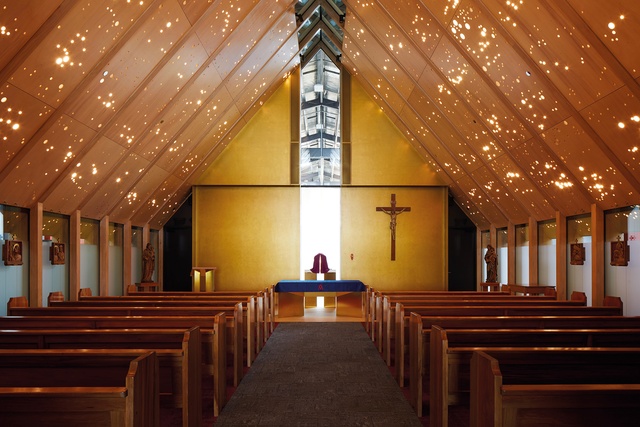
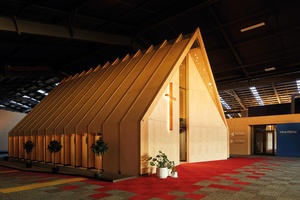
In the chapel, a central opening at each end of its gable roof leads the eye to see beyond the altar, past the crafted timber interior to the contrasting industrial steel purlins of the warehouse structure above. The existing steel columns and structure in the warehouse space, painted a uniform dark grey, reach towards the 9m roof apex. The classrooms, constructed out of strandboard-lined prefabricated walls, are stacked in two storeys like pieces of furniture within the cavernous industrial roof. When Sheppard & Rout Architects’ director Jasper van der Lingen and associate director Joff Kennedy first visited the site, the steel racking remained inside. The racking, briefly investigated for re-use on the site, was onsold for re-use elsewhere instead but it informed the initial dimensions and set-out of the spaces – a nod to the building’s previous use as a supermarket distribution centre. This gesture conveys the careful acknowledgment of the industrial fabric Sheppard & Rout has woven throughout design and construction, while also crafting a high-performing environment in which to learn.
The warehouse conversion movement arrived on New Zealand shores from SoHo, New York, in the early 1990s and, since then, these structures have been converted to housing, offices and commercial uses. However, this is the first time in our country that a warehouse has been adapted to suit a school. Minimal improvements were made to the exterior shell of the building, its purpose mainly to provide a weatherproof barrier; the classrooms and other introduced spaces were treated with their own thermal envelopes. This also meant the rooms did not need waterproof cladding, spreading the cost per square metre further and setting a precedent to which attention needs to be paid for future school projects. Two of the final bays were demolished to make way for an outdoor sports field. The remaining bays, with various construction dates spanning from the 1960s, had a new slab cast over the existing foundations and were strengthened, where needed, to meet Importance Level 3. One section of the warehouse roof was lifted off to create an outdoor courtyard and more natural light was allowed in with introduced skylights to the corrugated roof. In the remaining spaces, alongside the 26 classrooms, a chapel, a library, administration and staff offices, a gym and a performing arts ‘black box’ theatre room have been carefully placed. The volumes between are harnessed to create multifunctional spaces for assemblies and events, smaller breakout areas and four indoor sports courts. These large, undercover areas represent a luxury that could not have been realised without the re-use of the warehouse structure.
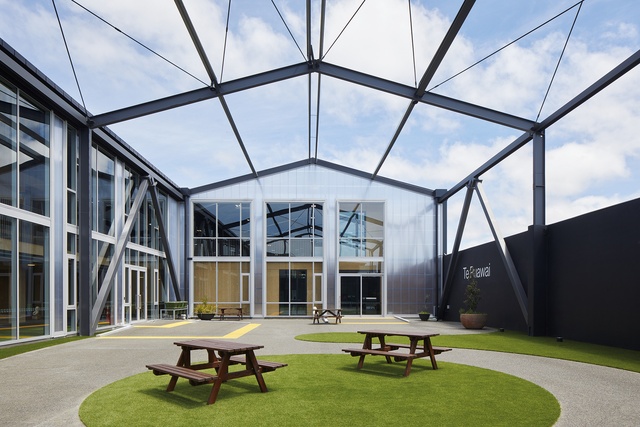
I hear youthful banter as I walk between the classrooms and see bags spill out of cubby holes: unmistakable marks that these spaces are inhabited comfortably by students, despite the enclosed nature of the school. This is the only New Zealand school to be completely sheltered between classes at this scale (although this is common in countries with harsher climates) but the internal environment feels busy and alive, any insular notions mostly mitigated by full-height windows, clear visual pathways and links, both internally and outdoors. Classrooms are single cells, with sliding doors enabling teaching flexibility. Because of the overhead covering, breakout spaces between the classes can also be utilised. This arrangement of learning environments is perhaps not too different from the Ministry of Education (MoE)’s design guidance.1 How much noise and moisture will 430 students generate under a singular roof? These challenges have been resolved nimbly with ducting, acoustic treatment, mechanical ventilation units and plumbing, both old and introduced, on display. A bit rough and ready around the edges, these provide a learning instrument for the students. A hold-down bracket in one of the internal library walls has been left visible to pique curiosity and demonstrate the way in which the new walls are structurally connected to the warehouse slab. In its drive to manage its environmental and social responsibilities, Marian College has become an advocate for change. This retrofit is an education tool for all its students and visitors – an example of sustainable and innovative design without the opulent budget – and has the eyes of the MoE watching its future performance keenly.
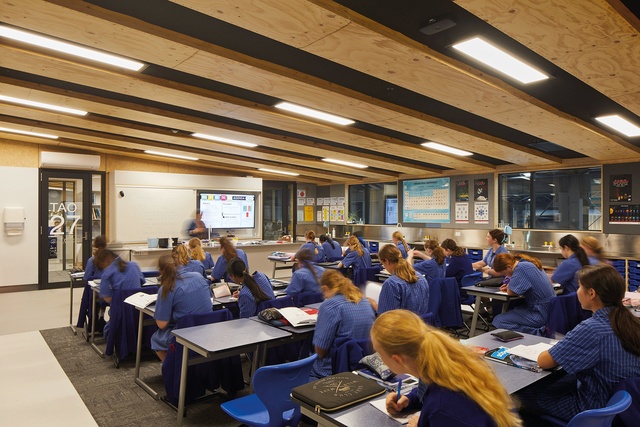
Delight and satisfaction (and, yes, sometimes frustration) were found in this warehouse conversion. With an estimated 30 per cent of waste attributed to the construction industry worldwide, rigorous consideration of existing structures is needed to reduce the carbon footprints of our builds. Re-use of Marian College’s warehouse shell alone has enabled a 64 per cent reduction in embodied carbon (representing 2,421,735kg CO2 or 368 return flights from Auckland to London)2 when compared to a reference school (a theoretical, same-sized school built to similar standards, with typical construction methods). As well as the re-use of the exterior fabric of the warehouse, timber elements were critical to keeping the school’s embodied carbon footprint low. All introduced internal structures are timber, reducing the retrofit’s footprint. Potius box beams, glulam and LVL are used and on display throughout. These timber components also make the space feel inhabitable, their warm tones inviting and, in the case of the strandboard classroom blocks, their size breaking down the scale of the mammoth warehouse. Timber technology needs to be embraced, says van der Lingen, raising a concern that there was a struggle with supply chain issues – a vulnerability the country needs to address if we want to build more in timber.
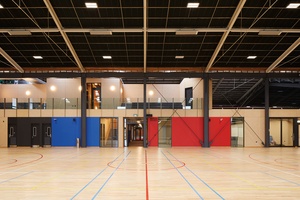
During construction, the school’s Green Star rating faced the chopping board, as a result of escalating costs, but Marian College held tightly to the vision it had shared with its community. This commitment to bringing the building’s concept into reality has already paid off – school applications have skyrocketed. The future-orientated design has designated areas for increasing the role to 600, which will likely be needed earlier than planned. Plans to fund its next needs, including its exterior grounds and an onsite pā, by hiring out areas of the warehouse for organised events, guarantee a multitude of witnesses to the success of the space and that its ideas are sown further afield.
Under the stars of Māhutonga, Marian College has undertaken a long journey to create its new, innovative home. It’s a site and building to grow into – with new furniture, landscaping and artwork to come. Marian College has taken a huge risk in forging this unusual home for its school and, in brave stewardship of its future, it has, perhaps, shaped the future of New Zealand schools to come.
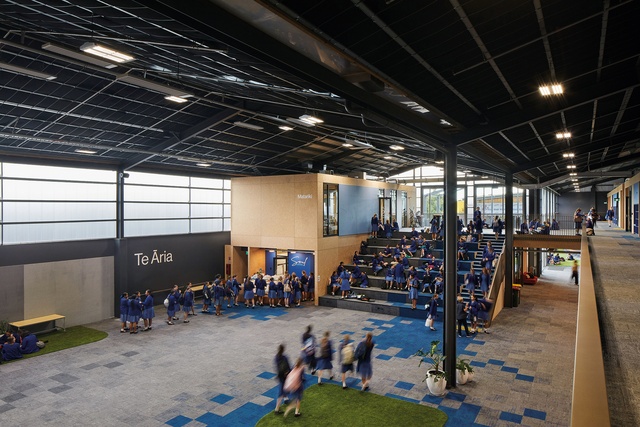
1 The MoE’s latest design guidance is based on Quality Learning Environments (QLEs), standards regarding physical properties such as acoustics, thermal comfort, lighting, etc., without an explicit expectation of any specific pedagogical approach.
2 clevel.co.uk/flightcarbon-calculator/


